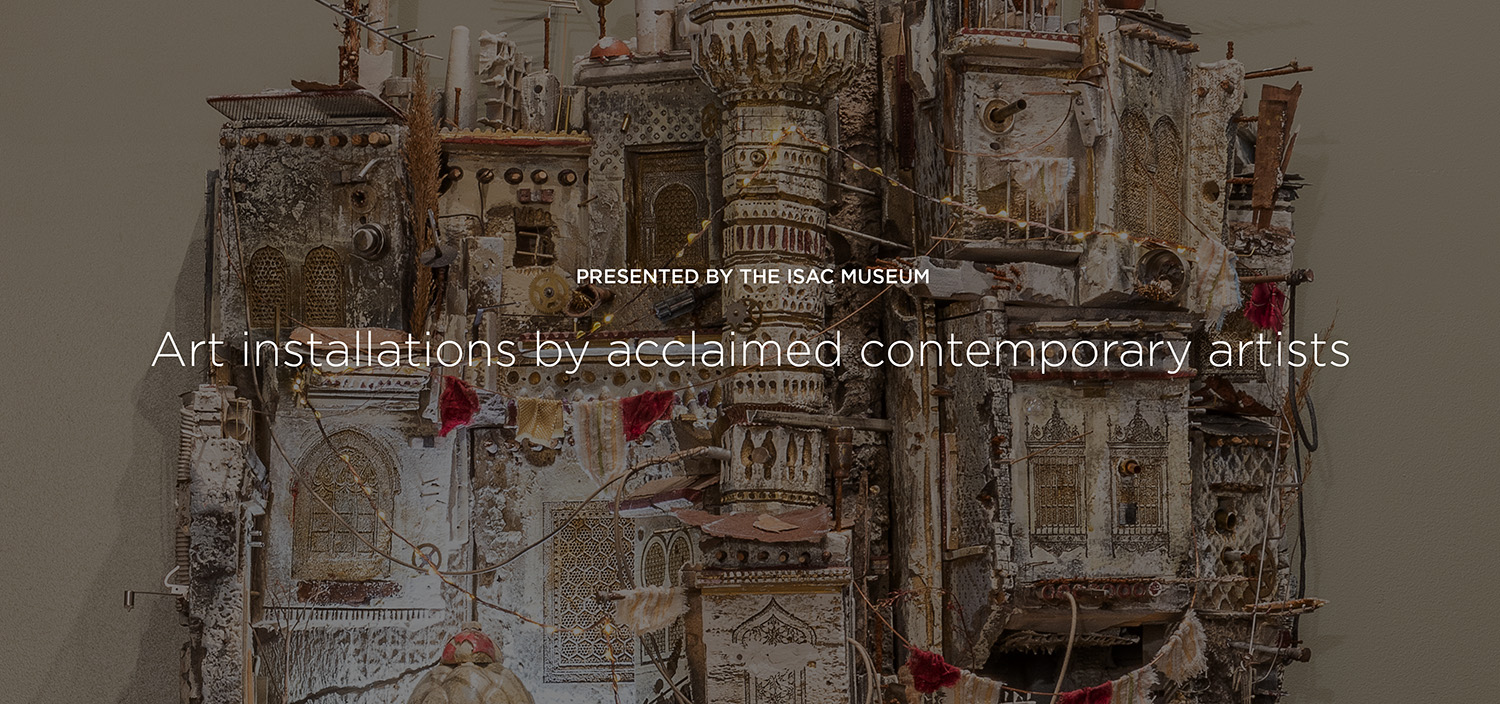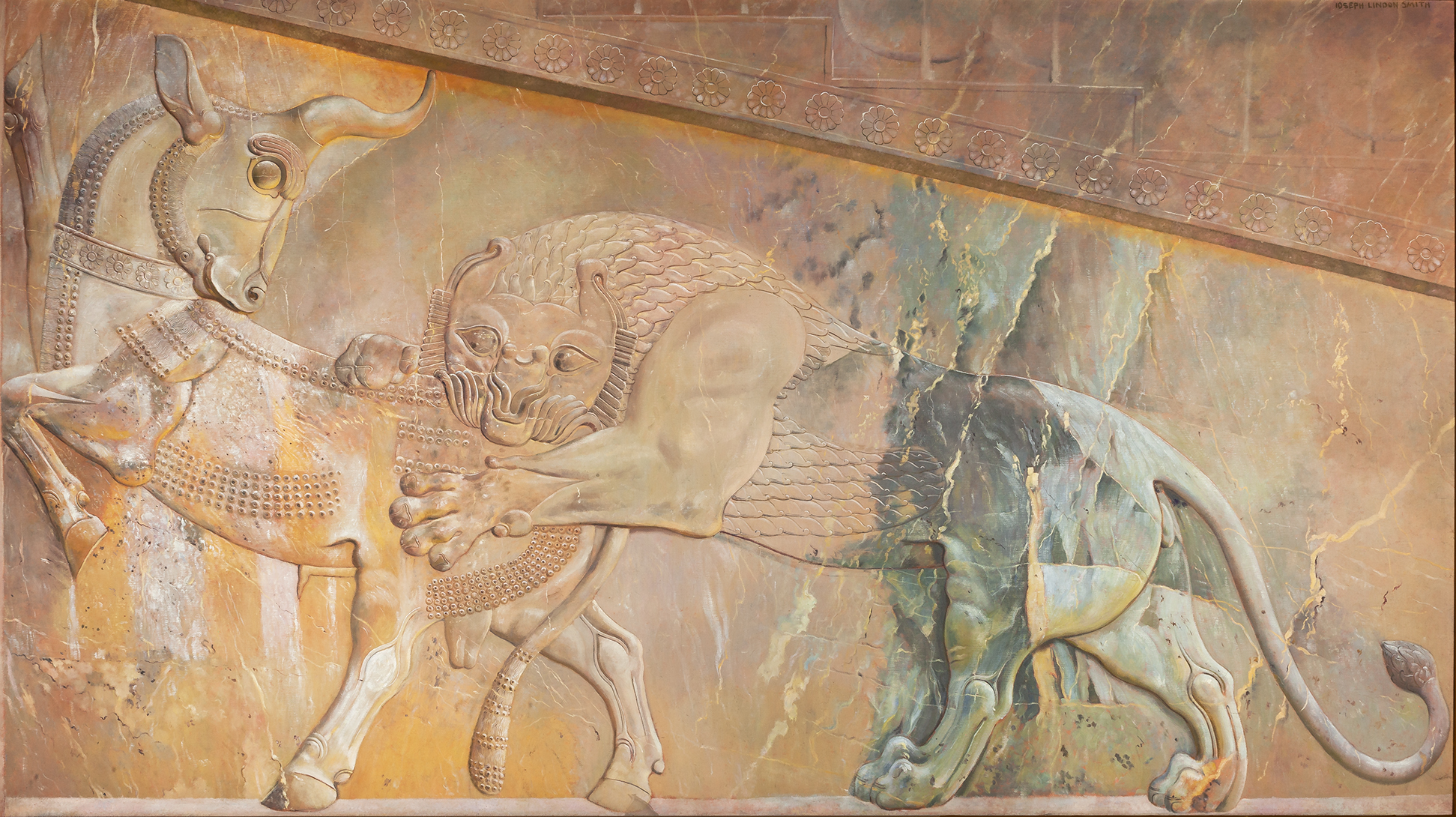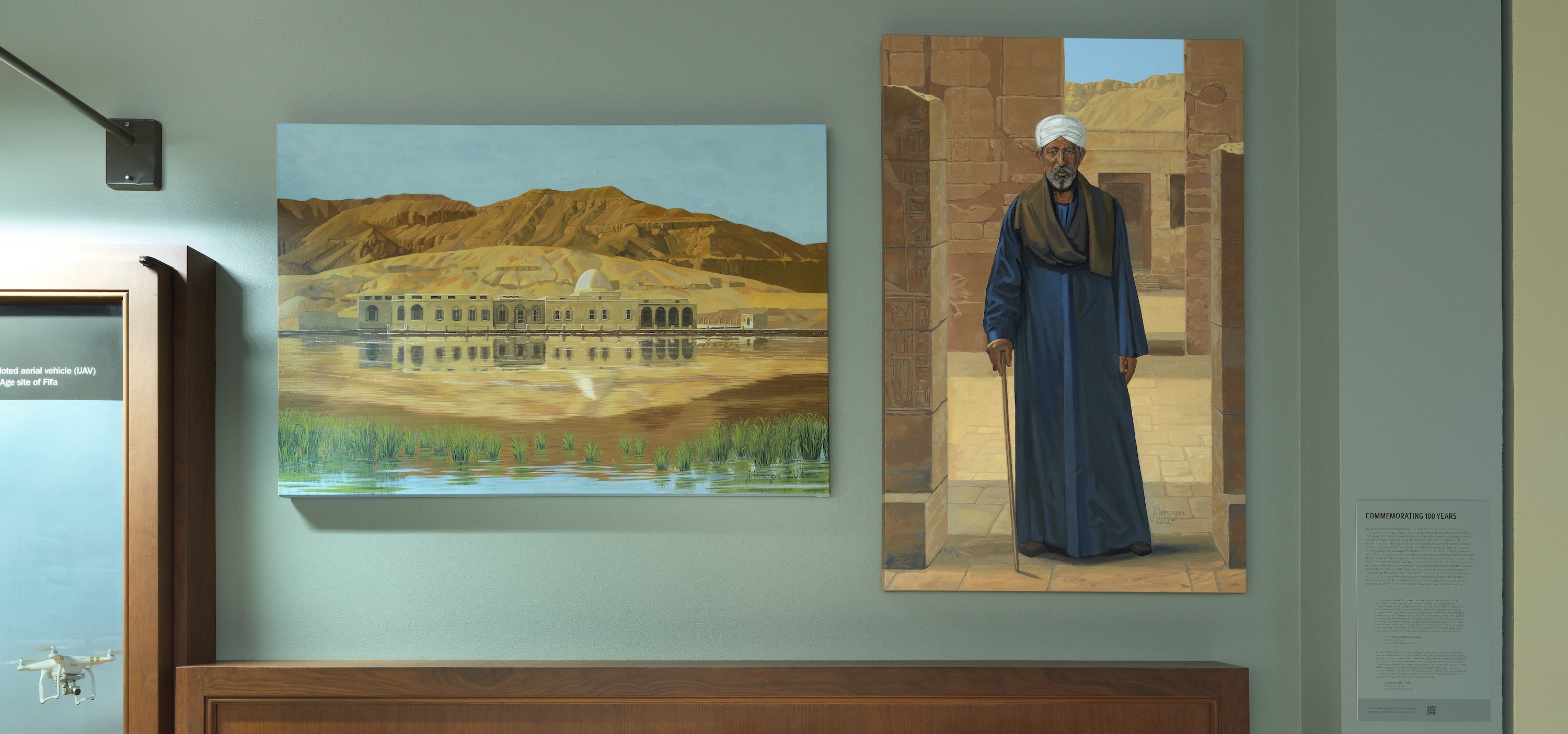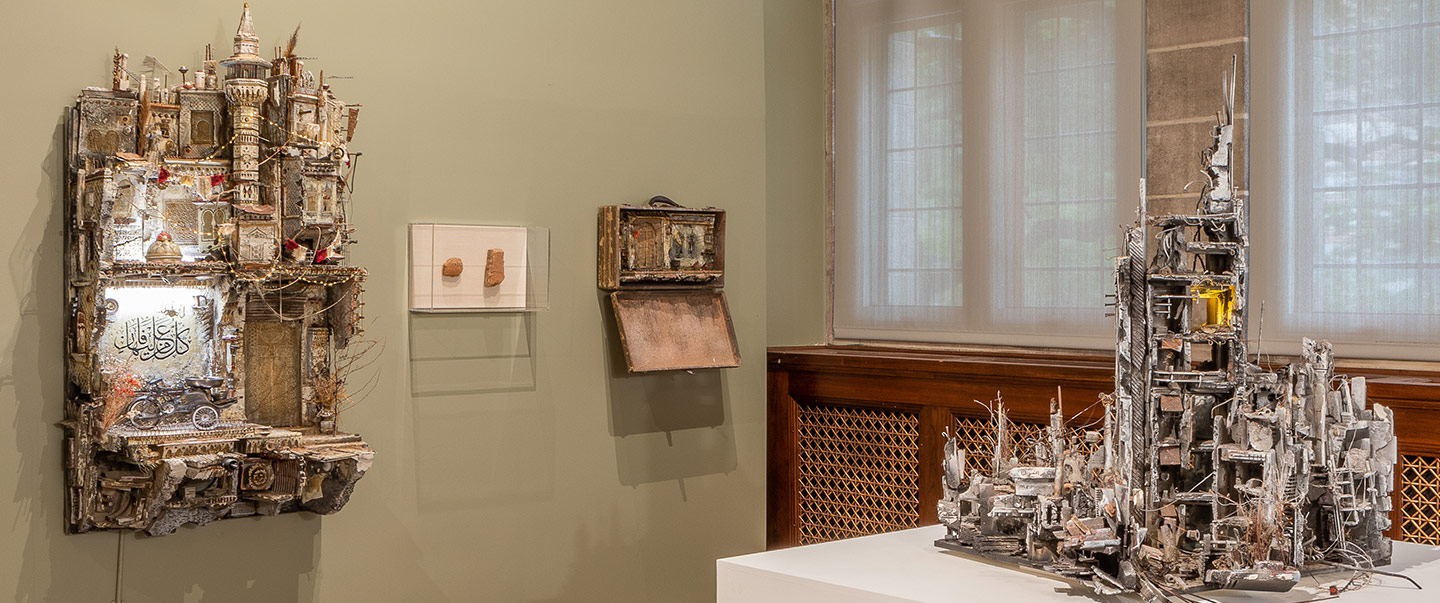Contemporary Art Installations

Contemporary Art Installations
Finding news ways to connect visitors to the ancient past
ISAC collaborates with internationally recognized contemporary artists to present new works inspired by the ISAC Museum's collection. Below are details on both present and past exhibitions.

Joseph Lindon Smith (February 2025–ongoing)
Joseph Lindon Smith (1863–1950), an American artist renowned for his faithful renderings of archaeological subjects, created six monumental paintings at the site of Persepolis in 1935 at the invitation of James Henry Breasted, the founder and director of ISAC. Accompanied by his wife, Corinna, Smith joined ISAC’s Persian Expedition for only six weeks. Using the 11½ meters of rolled-up canvas that traveled with him to Persepolis, Smith executed all six paintings freehand using the dry-brush technique. This approach resulted in greater realism and was especially impactful for rendering the textured surface of the stone sculpture of the Apadana staircase reliefs. However, it allowed for only minimal revisions once the oil paint had been applied to the canvas.
After finishing his work at Persepolis, Smith traveled first to Giza in Egypt (he was also a member of the joint Harvard University–Boston Museum of Fine Arts Expedition) and then to Chicago to deliver the paintings in person, altogether three landscape scenes and three to-scale portraits of sections of the Apadana staircase reliefs. Following a recent conservation project, three of the Persepolis paintings have been installed for long-term display on the upper walls of the Persian Gallery.
The conservation and exhibition of the Persepolis paintings has been made possible by a principal gift from the Ashtiani-Bonebrake Family. This project also benefited from the encouragement and support of Smith’s granddaughter, Linden Gaspar, and her husband, Charles J. Gaspar. “The preservation of this group of paintings from Persepolis serves to enhance the study of ancient cultures and to encourage students, both young and old, to delve further into my grandfather’s paintings of other parts of the ancient world.” —Linden Gaspar
FROM ISAC STAFF, 1935
Persepolis paintings perfectly glorious and certainly mark culminating point of his career... the whole project has been in every way a great success.
Prentice Duell, Field Director, ISAC's Saqqara Expedition

Johannes Weninger (2024–2025)
To celebrate the centennial of ISAC’s Epigraphic Survey and its headquarters at Chicago House in Luxor, Egypt, Johannes Weninger has prepared two paintings that evoke the Survey’s early history and current fieldwork: a landscape view of the old Chicago House on the west bank of the Nile and a portrait of the current Rais (Foreman) of the Epigraphic Survey, Badawy Abdullah Muhammad Abdul Rahman. In addition to their connection with the Survey, the two paintings are also linked via Rais Badawy himself, who is a representative of the well-known Abdul Rasoul family, of which another descendant currently owns the old Chicago House, now operated as a popular hotel and restaurant for visitors to Luxor’s west bank. The portrait of Rais Badawy also stands as a tribute not only to an individual with whom Weninger has worked for a decade and who is a pillar of the Survey’s fieldwork, but also to all the skilled yet unsung local laborers in the history of archaeology.
Johannes Weninger is a German-American artist and stone cutter who began his artistic journey while growing up in the foothills of Northern California. He paints in oil, acrylic, and watercolor, specializing in portraits and cultural heritage paintings; he shares his time between Chicago and Luxor each year. The installation of this pair of paintings, titled "In Harmony with the Landscape" and "Guardian of the Temple," complements the ISAC Museum special exhibition, Chicago on the Nile: 100 Years of the Epigraphic Survey in Egypt (September 17, 2024–March 23, 2025).
FROM THE GALLERY LABEL
The sequence of doorways visible in the background, along with Rais Badawy’s galabiya (robe), scarf, and staff, emphasize the Rais’ traditional role as the guardian of the temple. Seen with these traditional insignia of office within this ancient environment, he embodies the coexistence of ancient and modern Egyptian heritage.

Michael Rakowitz (2019–ongoing)
As part of his series The invisible enemy should not exist, Iraqi-American artist Michael Rakowitz has collaborated with the ISAC Museum to create a reappearance of a relief from the Northwest Palace at Nimrud, destroyed by Isis in 2015. Integrating an ancient fragment from the ISAC Museum collection, his piece uses contemporary Middle Eastern newspapers and packaging from northern Iraqi foods. On display in the ISAC Museum Assyrian Galleries.
Michael Rakowitz is an artist living and working in Chicago. His work has appeared in venues worldwide including dOCUMENTA (13), P.S.1, MoMA, MassMOCA, Castello di Rivoli, the 16th Biennale of Sydney, the 10th and 14th Istanbul Biennials, Sharjah Biennial 8, Tirana Biennale, National Design Triennial at the Cooper-Hewitt, and Transmediale 05. He has had solo projects and exhibitions with Creative Time, Tate Modern in London, MCA Chicago, Lombard Freid Gallery in New York, Galerie Barbara Wien, Berlin, Rhona Hoffman Gallery, Chicago and Kunstraum Innsbruck. He is the recipient of the 2018 Herb Alpert Award in the Arts; a 2012 Tiffany Foundation Award; a 2008 Creative Capital Grant; a Sharjah Biennial Jury Award; a 2006 New York Foundation for the Arts Fellowship Grant in Architecture and Environmental Structures; the 2003 Dena Foundation Award, and the 2002 Design 21 Grand Prix from UNESCO. He was awarded the Fourth Plinth commission in London’s Trafalgar Square, on view through 2020. A survey of his work is on view at Whitechapel Gallery in London and will travel to Castello di Rivoli Museo d’Arte Contemporanea in Torino in 2019 and The Jameel Arts Centre in Dubai in 2020. Rakowitz is Professor of Art Theory and Practice at Northwestern University.FROM THE GALLERY LABEL
Maybe we Iraqis felt hurt when we saw our monuments displayed outside of Iraq. We get hurt because it's our civilization… I wasn't as devastated when they (ISIS) destroyed my house or when they killed some of my relatives because this is life — all of us die. But Nimrud was like a part of our family. This heritage was part of our lives, part of all of Iraq.
Sheikh Khalid al-Jabbouri

Mohamad Hafez (2019–2022)
Syrian artists and architect Mohamad Hafez exhibited works at the ISAC Museum including Hiraeth and Collateral Damage. His works and associated public programming as the OI’s first interpreter-in-residence explored the links between the loss of ancient artifacts in the Middle East and contemporary loss of human life and human suffering in Syria and other parts of the Middle East. Exhibited in the Mesopotamian Gallery September 2019–December 2023.
Mohamad Hafez is an interdisciplinary artist and architect born in Syria, raised in Saudi Arabia and educated in the Midwestern United States. A self-taught sculptor, Hafez uses his expertise as a licensed AIA architect as well as his lived experience of Damascus’s rich built environment to create poetic streetscapes high in fidelity and charged in content. His mixed-media sculptural compilations of objects anchor uneasy conversations, stimulating deeper audience engagement on contentious topics like torture and prisoner abuse, child starvation in Africa, or the ongoing global refugee crisis. Hafez studied at Damascus University and Northern Illinois University before earning his B.Arch. at Iowa State University in 2009. Hafez began practicing sculpture shortly after coming to the U.S. in 2003, out of homesickness and nostalgia provoked by prohibitive Bush-era NSEERS travel restrictions. Hafez has exhibited at The Brooklyn Museum, UNICEF House, NYC; Orlando Museum of Art, Florida; Yale Art Gallery, New Haven; and Contemporary Art Platform, Kuwait, among others. He has received national attention in the New York Times, The New Yorker, Boston Globe, AJ+, Global Citizen, The Guardian, and NPR. Hafez is currently full-time with the firm Pickard Chilton and was Project Lead Designer on the 2017 50-story, 1.5 million GSF office tower 609 Main in downtown Houston, TX. Hafez is the recipient of a 2018 Connecticut Arts Hero Award for his extensive and continuous body of work on issues such as the Syrian civil war, the worldwide refugee crisis, and an overall desire to counter hate speech.He serves as a 2018 Yale University Silliman College Fellow and artist-in-residence at the Keller Center of Harris School of Public Policy, University of Chicago.
FROM THE ARTIST
The fabric I use in my laundry lines, called aghabanni, comes from Syria. In my last trip before the war, I asked a textile merchant to give me some of his scrap fabrics. Each little piece is attached somehow to a nostalgic memory of something.
Mohamad Hafez

Ann Hamilton (2019)
Ann Hamilton, recipient of the National Medal of Arts and a MacArthur “Genius” Fellowship, created a new large-scale installation in the Grand Reading Room of UChicago’s Joe and Rika Mansueto Library for her project aeon, affixing to the room’s massive glass dome a series of translucent images of ISAC artifacts that she produced using a small flatbed desktop scanner and a handheld wand scanner. After several thousand years entombed underground, and nearly a century enclosed in the ISAC Museum's display cases, the ancient figures are illuminated and “animated” through Hamilton’s ethereal images. Exhibited September 18–December 15, 2019.
FROM THE ARTIST
The liveness of the object draws us toward it, makes a connection, sparks curiosity.
Ann Hamilton

